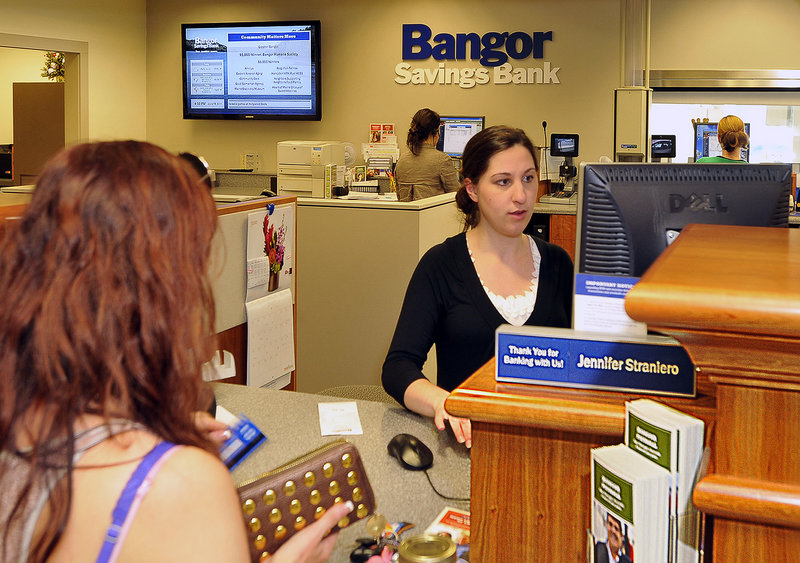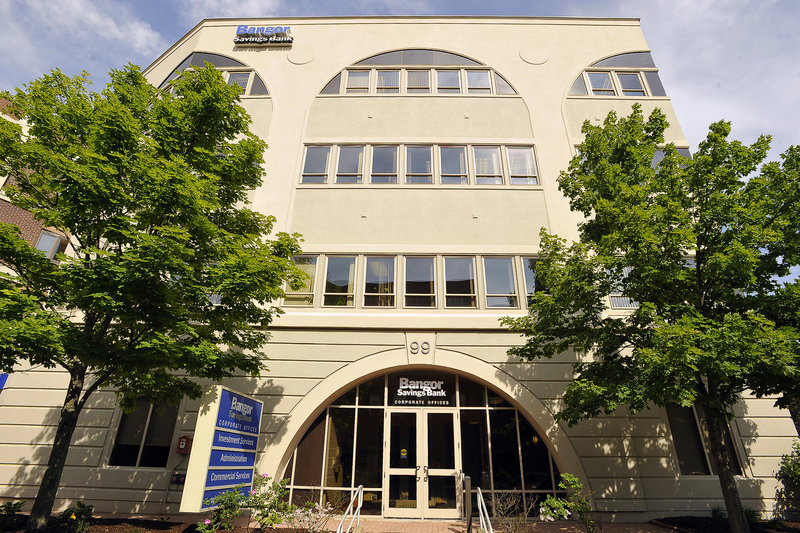BANGOR – An elaborately engraved vault door of polished steel is mounted in Bangor Saving Bank’s Franklin Street offices.
It’s for display only — there’s no vault behind it.
But executives say the door is more than decorative. Salvaged from the bank’s original State Street offices, which burned in the Bangor Fire of 1911, it symbolizes a long Maine heritage.
Now the state’s largest bank by assets, Bangor Savings has branches throughout Maine, 700 employees and recently completed a major expansion in Greater Portland.
Top managers say conservative business practices and strong community relations keep the bank healthy. But at the same time, they are coping with a flat economic environment and industry uncertainty created by new federal regulations.
“Our bank has been around 160 years … and we will be judged by, ‘Is this bank going to be here a hundred years from now?’ ” said Bangor Savings President and CEO James Conlon. “The impact of regulatory reform is unknown. The business model five years from now will look different than today.”
Elijah Livermore Hamlin led a group of 24 men to launch Bangor Savings Bank on May 5, 1852, a time when Bangor — the “Queen City” — was a booming lumber town.
Hamlin worked as a lawyer, state senator, state representative, mayor and entrepreneur. His younger brother was Hannibal Hamlin, vice president to Abraham Lincoln between 1861 and 1866, during the Civil War.
Though the company’s offices burned in 1911, the vault remained intact, and $5 million in securities were salvaged, according to “Here For Generations,” a 2002 book by Dean Lawrence Lunt about the company.
In the early 1980s, Bangor Savings had assets of $318.8 million and 12 branches. In 1998, when it purchased 28 branches owned by Fleet Bank of Maine, it tripled its number of branches and saw its total assets swell to about $1.2 billion.
Today, Bangor Savings has 56 branches, most in central and southern Maine, and employs roughly 700 staffers, including 300 who work at the branches and 80 in Portland.
The company has a 196-staff technical center on Hammond Street in Bangor, where customer service agents field calls and IT staffers keep systems running. (There’s also a backup IT center in Portland.)
Bangor Savings operates a payroll outsourcing service in the tech center that processes roughly 110,000 payroll checks monthly for about 40,000 Mainers at 1,950 companies, said Chief Operations Officer Bob Montgomery-Rice.
Yellow Light Breen, Bangor Savings executive vice president and chief strategic officer, said that 10 years ago the company operated in just three of the top 20 markets by population in Maine. Today, the company operates in 12 of those markets, including Portland, which Bangor Savings entered in 2005.
Today, there are eight Portland-area branches, four of which opened since 2010.
40 PERCENT MARKET SHARE
Breen said the company has roughly 40 percent market share in Bangor.
Based on assets of $2.32 billion for the fiscal year that ended in March 2010, Bangor Savings is the largest Maine-based bank. The second largest, publicly-traded Camden National Bank, had assets of $2.31 billion in 2010, according to Camden’s annual report.
Bangor Savings had earnings of nearly $16.9 million in 2010, up from $16.5 million in 2009.
The company releases financial results for the year ending March 2011 on Monday. Conlon declined to discuss specific financial numbers, but said, “We will report another record earning year.”
The banking industry in the United States has undergone significant change in recent years.
Leading up to the recession, lending standards loosened and financial institutions began buying loans, creating a speculative market.
“It was a typical bubble,” said Breen. “Everyone thought selling mortgages was no longer risky.”
Breen said the industry “began to unwind” in late 2007, with the “most stressful” moments coming in the fall of 2008, when Lehman Brothers declared bankruptcy and when, during one day in September, Wachovia Bank depositors withdrew some $5 billion of the bank’s roughly $450 billion in deposits, according to reports. Wells Fargo Bank later acquired Wachovia.
“Confidence is the essence of the banking system,” said Breen, but in 2008 consumers were questioning if their money was secure.
Executives say many smaller, community banks, including Bangor Savings, largely didn’t participate in the practices that led to the financial crisis.
“We didn’t do stupid loans. We didn’t get involved in sub-prime (mortgages). We didn’t get involved in a lot of these toxic assets,” said Conlon.
He added, “Neither did most banks in Maine.”
Christopher Pinkham, president of the Maine Bankers Association, agreed, saying that banks in Maine and throughout New England have historically had “relatively conservative” lending and underwriting requirements compared to banks elsewhere.
NO GOVERNMENT ASSISTANCE
And Bangor Savings did not receive financial assistance through the government’s Troubled Asset Relief Program, which was aimed at minimizing the sub-prime mortgage crisis.
“I don’t want to have the government as a partner,” Conlon said.
Bangor Savings executives stress the company’s involvement in Maine communities. The bank’s community lending division writes loans to nonprofit organizations, like development groups Avesta Housing and Coastal Enterprises Inc. The Bangor Savings Bank Foundation donated $100,000 in 2010 to 68 nonprofits throughout the state.
The company also sponsors community programs like Lemonade Day Maine, a June event teaching kids about business and philanthropy. And Bangor Savings invested $100,000 to help produce “The Way We Get By,” a 2009 documentary film about seniors who greet returning soldiers at Bangor airport, said Breen.
Conlon said there are plenty of communities in Maine where Bangor Savings can expand. He said the company may grow through acquisitions.
But Bangor Savings has no intention of opening branches in other states.
“Our market share is so small in so many areas, we have all we can do for Maine growth,” he said.
Conlon said Bangor Savings has products, services and infrastructure that match those of the biggest banks, including Bank of America and TD Bank.
Pinkham at the Maine Bankers Association said there are 28 banks based in Maine and four that have significant Maine operations but are based elsewhere. Those 32 banks have assets exceeding $26 billion, said Pinkham, citing 2010 data from the Federal Deposit Insurance Corp.
Conlon said banking competition in Maine is stiff, with many banks competing for relatively few commercial loans. He said businesses in Maine seem healthier today than two years ago, but are largely not ready to assume more debt.
REGULATIONS’ IMPACT UNKNOWN
Conlon’s top concern is the impact of new federal regulations from the so-called Dodd-Frank bill, a sweeping overhaul of the nation’s financial regulatory environment aimed at preventing future financial meltdowns and increasing consumer protection. The bill, which touches nearly every sector of the financial system, also creates the new Consumer Financial Protection Bureau and limits larger banks’ debit card processing fees.
Conlon said the industry can’t begin to predict the impact of the regulations, which are still being written.
“What banks like is predictability. One of the biggest struggles you have is that there is no predictability on the regulatory front. What is true two days ago is not true today,” Conlon said.
He thinks the regulations will increase banks’ costs, and that many of them will not address causes of the crisis.
“There will be more rules (and) more regulations, 90 percent of which (have) nothing to do with the financial meltdown,” he said.
Conlon said Bangor Savings will adjust, but added that the company’s success ultimately lies in the “vibrancy” of the Maine economy.
“At the end of the day, our success is directly tied to the economy of Maine,” said Conlon. “Anything that can (help) Maine be more vibrant, I am interested in. When you talk about the tax burden and (efficiency) in state government — those are good steps.”
Jonathan Hemmerdinger can be reached at 791-6316 or:
jhemmerdinger@mainetoday.com
Send questions/comments to the editors.




